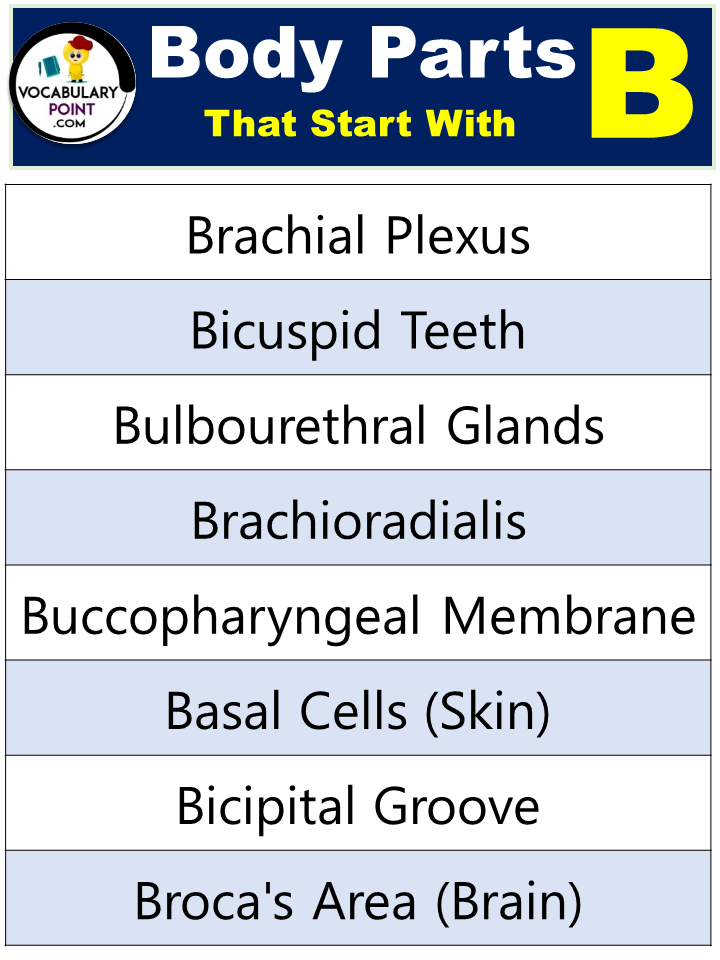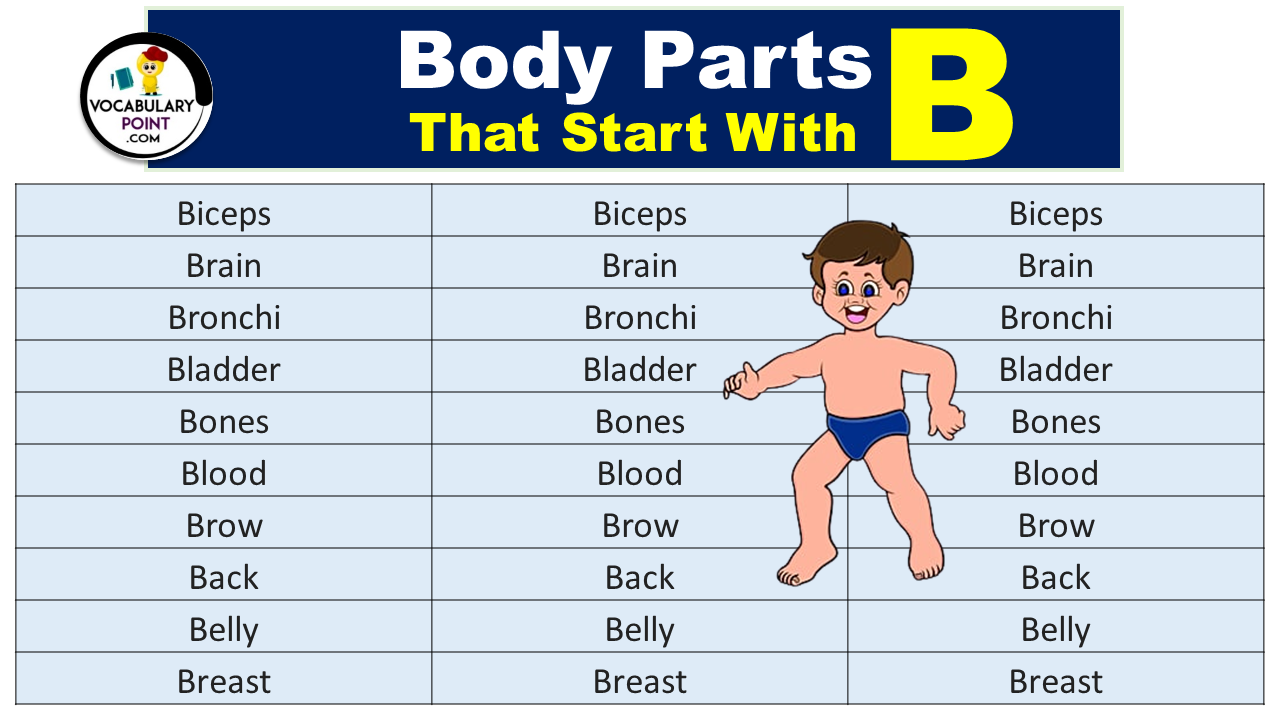The human body is a complex and fascinating structure, comprising various parts that function in harmony. Understanding these parts is essential for students beginning their journey in biology or anatomy. In this section, we explore body parts that start with the letter ‘B’, enriching our knowledge of human anatomy.
Body Parts That Start With B
- Biceps
- Brain
- Bronchi
- Bladder
- Bones
- Blood
- Brow
- Back
- Belly
- Breast
- Buttocks
- Bile
- Biceps Brachii
- Brachialis
- Buccal Cavity
- Bicuspid Valve
- Brachial Artery
- Basilic Vein
- Bronchioles
- Bone Marrow
- Brachial Plexus
- Bile Duct
- Bulbourethral Gland
- Bowman’s Capsule
- Buccinator Muscle
- Big Toe
- Biceps Tendon
- Back Muscles
- Ball of Foot
- Brachioradialis
- Bellybutton (Umbilicus)
- Basal Ganglia
- Bunion
- Bulbar Conjunctiva
- Broca’s Area
- Brainstem
- Bridge of Nose
- Biceps Femoris
- Baby Teeth
- Biopsy Tissue
- Brachial Vein
- Buccal Mucosa
- Blood Vessels
- Blood Cells
- Basophils
- Beta Cells (Pancreas)
- Bartholin’s Glands
- Body Hair
- Birthmarks
- Braille Receptors
- Brush Cells (Nose)
- Blast Cells
- Bell’s Nerve (Facial Nerve)
- Bregma (Skull)
- Blood Platelets
- Blood Plasma
- Balanopreputial Lamina
- Bone Surface
Explore More:
(A, B, C, D, E, F, G, H, I, J, K, L, M, N, O, P, Q, R, S, T, U, V, W, X, Y, Z)
Body Parts Beginning With B (And Their Properties)
- Brain: The primary organ of the central nervous system, responsible for processing sensory information, regulating body functions, and cognitive abilities.
- Bladder: A muscular sac in the pelvis, storing urine from the kidneys before disposal.
- Bronchi: The main passageways into the lungs, branching from the trachea and allowing air to reach the lung tissue.
- Biceps: A large muscle in the upper arm that flexes the elbow.
- Brow: The area of the face above the eyes; often involved in facial expressions.
- Bile Duct: A tube that carries bile from the liver and gallbladder to the intestine.
- Basilic Vein: A large vein located in the upper limb, commonly used for intravenous access or blood draw.
- Buccal Cavity: The mouth’s interior, including the cheeks, gums, and teeth.
- Ball of the Foot: The padded area of the foot just behind the toes.
- Belly Button (Navel): The scar on the abdomen where the umbilical cord was attached.
- Buttocks: The rounded portions of the anatomy located on the posterior of the pelvic region.
- Bile: A digestive fluid produced by the liver and stored in the gallbladder.
- Bicuspid Valve (Mitral Valve): A valve in the heart that lets blood flow from the left atrium to the left ventricle.
- Biceps Femoris: A muscle of the thigh, part of the hamstrings group, involved in knee flexion.
- Brachial Artery: The major blood vessel of the upper arm.
- Bulb of the Penis: The root part of the penis, which connects to the pelvic bone.
- Brachial Plexus: A network of nerves that conducts signals from the spine to the arm and hand.
- Buccal Mucosa: The lining of the inside of the cheeks.
- Bone Marrow: Soft tissue inside bones, producing blood cells.
- Breastbone (Sternum): A long flat bone located in the center of the chest.
- Bronchioles: Small branches of the bronchi that lead to the alveoli in the lungs.
- Biceps Brachii: A muscle in the upper arm that flexes the forearm.
- Bartholin’s Glands: Glands located near the vaginal opening in females, secreting lubricating fluid.
- Bursa: A small fluid-filled sac that reduces friction between bones and tissues.
- Brachialis Muscle: A muscle in the upper arm that flexes the elbow.
- Bulbar Conjunctiva: A thin layer of tissue covering the white part of the eye.
- Buccinator Muscle: A facial muscle that compresses the cheek.
- Bony Orbit: The bony cavity containing the eyeball.
- Brachiocephalic Artery: A major blood vessel of the circulatory system, supplying blood to the head, neck, and arms.
- Basal Ganglia: A group of structures linked to the thalamus in the base of the brain, involved in coordination of movement.
- Buccal Fat Pad: Fat tissue located in the cheeks.
- Biceps Tendon: The tendon that connects the biceps muscle to the bones of the shoulder and elbow.
- Bilateral Nares (Nostrils): The two openings of the nose.
- Buccal Nerve: A nerve that provides sensory innervation to the cheek.
- Bronchial Tubes: Tubes that carry air from the trachea to the lungs.
- Brachioradialis Muscle: A muscle of the forearm that flexes the forearm at the elbow.
- Buccal Glands: Salivary glands located inside the mouth.
- Blood Vessels: Tubular structures carrying blood through the body, including arteries, veins, and capillaries.
- Bipolar Cells (Eye): Cells in the retina that play a role in visual processing.
- Bulbospongiosus Muscle: A muscle of the urogenital triangle in both sexes.
- Bulbar Urethra: The part of the urethra closest to the bladder.
- Basilar Artery: An artery supplying blood to the brain.
- Bones of the Hand: The 27 bones forming the human hand, including carpals, metacarpals, and phalanges.
- Bones of the Foot: The 26 bones forming the human foot, including tarsals, metatarsals, and phalanges.
- Brachial Vein: A vein accompanying the brachial artery, draining blood from the upper limb.
- Body of the Pancreas: The middle part of the pancreas, between the head and the tail.
- Buccal Branch of the Facial Nerve: A branch of the facial nerve that controls the buccinator muscle.
- Brachialis: A muscle in the upper arm that flexes the elbow joint.
- Broad Ligament: A peritoneal fold that attaches the uterus, fallopian tubes, and ovaries to the pelvis in females.
- Bowel: The intestine, part of the digestive system, including the small and large intestines.

Other Body Parts Starting With The Letter B
- Brachial Plexus
- Bicuspid Teeth
- Bulbourethral Glands
- Brachioradialis
- Buccopharyngeal Membrane
- Basal Cells (Skin)
- Bicipital Groove
- Broca’s Area (Brain)
- Bicipital Aponeurosis
- Brow Ridge
- Bulbar Palsy
- Brachiocephalic Vein
- Bregma (Skull)
- Baculum (in certain mammals)
- Buccal Branch (of Cranial Nerve)
- Bergmann Glia (Brain)
- Bony Labyrinth (Ear)
- Brachial Vein
- Batson’s Plexus
- Basilar Membrane (Ear)
- Biliverdin (in blood)
- Buccinator Crest (Jaw)
- Blood-Brain Barrier
- Body of the Mandible
- Biatrial Enlargement (Heart)
